Our backyard ponds were our first step into outdoor aquaculture. The design philosophy behind it was to get a system going to see what was involved in keeping fish alive year round in an outdoor environment. Originally, we had planned on getting an above ground swimming pool. There were several available and we purchased a 10′ diameter one for just under $100.00. It had a 1000 gallon capacity. As we began to figure out the logistics, we realized that our dog JoJo might decide to take a dip possibly penetrating the soft floor with his claws. So, we backtracked on the pool idea and then came across two plastic pond shells for sale on Craig’s list. They didn’t have the holding capacity of the 10′ pool, but it would still be a good start.
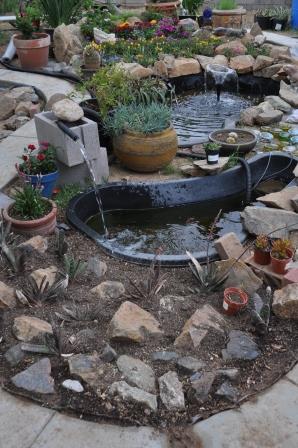
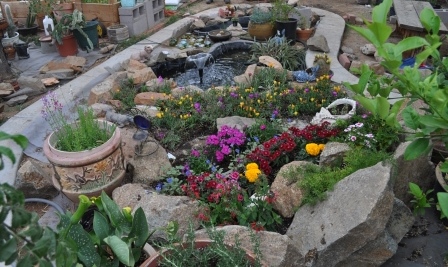
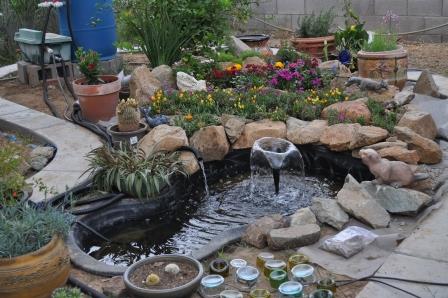
Both ponds were 2 tier or level. The smaller one has one shelf that you would put an aquatic plant on, and the larger had two larger shelves. Our first idea was to bury each one up to the shelf level and then build up dirt to the edges, enclosing the area with cinder blocks.
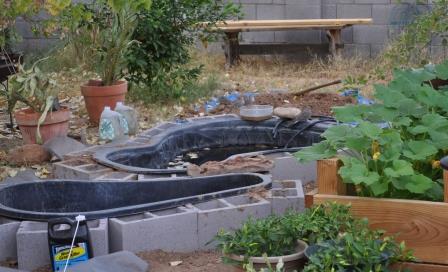
For a lot of logistical reasons, this idea just didn’t work out. We dug bigger holes and put the ponds in the ground all the way to the lip.
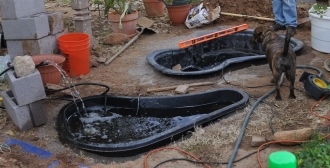
The ponds came with one filter. It was a commercial one that had a pump inside a media filled plastic box that sat in the pond. The pump inside the box fed a rectangular filter box that had an ultraviolet light chamber which overflowed into a tray with another pad to filter solids on top of a flow through filled with lava rock. This box would be positioned above the level of the pond so the cleaned/filtered water would then gravity flow back into the pond. The guy I bought it from said that it kept the big pond very clean. I had other ideas for a filter.
The Barrel Filter. I got this idea from a website I came across while looking to make inexpensive filters. If you get into this kind of stuff, you will find plenty of manufactured products to help you along the way. They are affordable for small scale ideas. If you want to get into aquaponics, you will not stay small scale for long, and the commercial products will kill your budget. Besides, I’m a DIY guy with a small budget, so I look to solutions outside of the commercial realm. I purchased a 55 gallon food grade barrel with a removable lid – I think it cost about $35. The reason I paid more to get a barrel with a lid is that it allowed me to do the internal plumbing and then seal it back up again easily. I drilled two holes near the top edge and put in 1″ PVC bulkhead fittings. I then put PVC inside the barrel going down to the bottom. This was where the water would come into the filtration system. The second hole acted as the overflow and return to the pond. I also put ball valves on each so I could perform maintenance and not have issues with water back-flowing into the pond. The pump to run the whole thing sits in the pond and is my usual 600 gallon per hour model. I like this configuration because it allows me to do maintenance on the pump without having to worry about opening up the barrel. Inside the barrel, the water passes through six lingerie bags filled with lava rock. Then the water passes through three layers of swamp cooler filter pads and finally gets to the overflow pipe.

I wanted to run both ponds on this one filter, but quickly realized that the overflow rate would be very difficult to manage. On paper, it sounds fine. Two 600 gallon per hour pumps feeding 1 filter with an overflow back to each pond. The reality is, if one pump got clogged up while the other one didn’t, the difference in water flow would easily flood the other pond, creating a disaster. So the barrel filter became the filter for the large pond and I would have to figure out something else for the smaller pond. In the beginning, I used the filter I got with the original ponds, but eventually, I made a 5 gallon bucket version of the one above feeding it with a 260 gallon per hour pump.
Later on in the year as it got cold, I wrapped the barrel in fiberglass insulation (spare from another project) and put a tarp over it for protection from the weather.
To be continued…